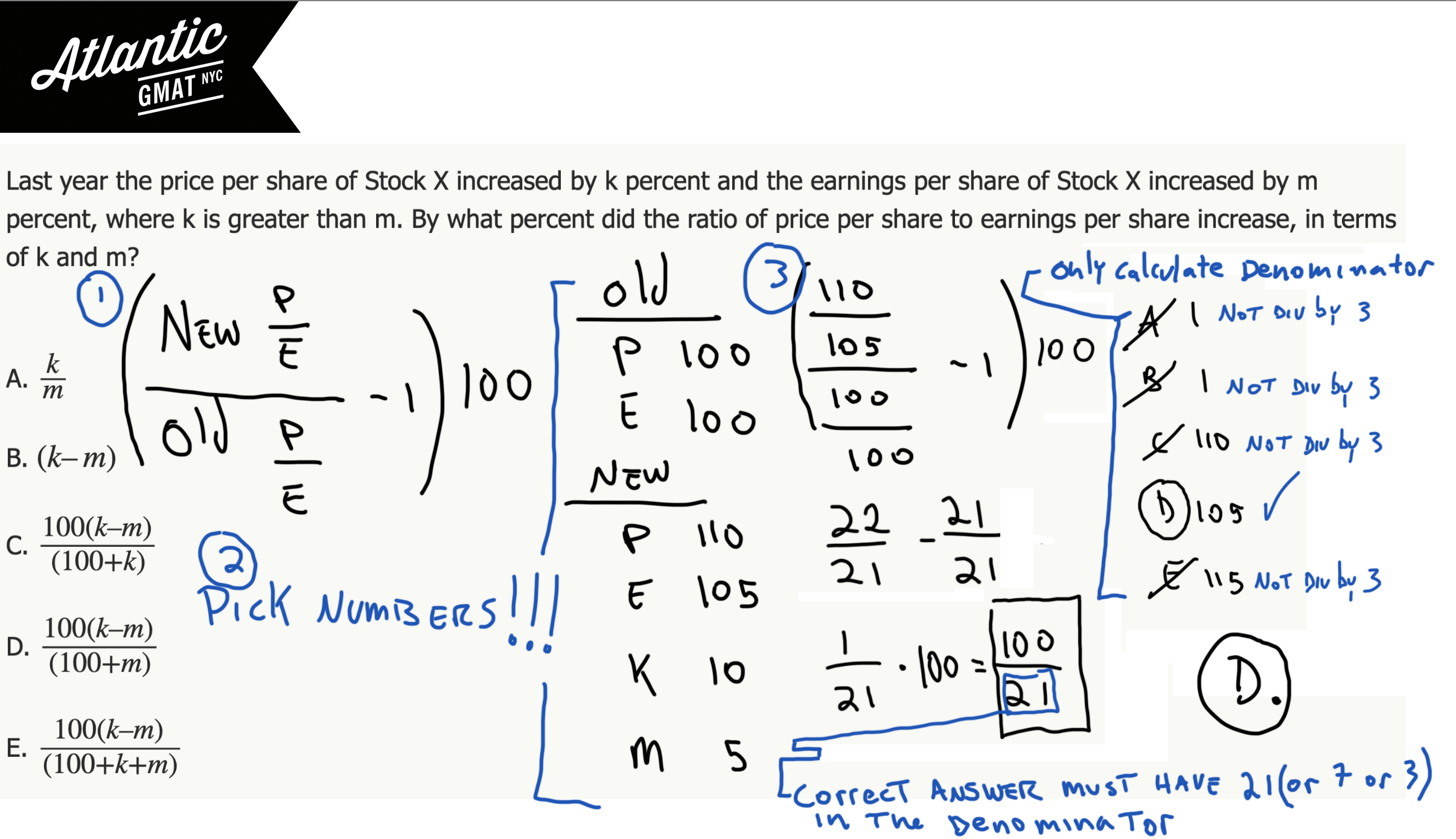Last year the price per share of Stock X increased by k percent and the earnings per share of Stock X increased by m percent, where k is greater than m. By what percent did the ratio of price per share to earnings per share increase, in terms of k and m? GMAT Explanation, Video Solution, and More Practice!
Last year the price per share of Stock X increased by k percent and the earnings per share of Stock X increased by m percent, where k is greater than m. By what percent did the ratio of price per share to earnings per share increase, in terms of k and m?
A. k/m
B. (k–m)
C. 100(k–m)/(100+k)
D. 100(k–m)/(100+m)
E. 100(k–m)/(100+k+m)
This is a very challenging percent change word problem with a ton of variables from the GMAT Official Guide. A few things to remember when working on word problems:
- Read carefully. Digest the text as you read.
- Define the question before starting calculations (use the nouns to define the question you don’t have to fill in the numbers)
- Solve thoughtfully. Avoid simply burrowing in. Zoom in/Zoom out. Pause. Think.
Since there are variables in the answer choices this is a good candidate for: picking numbers.
Now, let’s also remember the practical picking numbers test. If the question would be easier if you simply had the numbers then go ahead and pick them! This question would just be a percent change. So I’d say that is a clear signal to pick numbers.
Alright, we’re getting a little ahead of ourselves. Let’s go ahead and define the question: By what percent did the ratio of price per share to earnings per share increase, in terms of k and m?
That’s it, no more no less. In tutoring sessions students often struggle getting this question defined. The question is always just that last line and doesn’t need interpretation. If you’re having trouble defining it just read the last line to yourself word by word verbatim. Often, if you’re confused it’s because you missed a word or added a word or two. Avoid paraphrasing here.
What gets missed on this one? That you’re comparing RATIOS. It’s the percent change of the RATIO of price per share to earnings per share. It’s not Price compared to Earnings. It’s P/E last year compared to P/E now.
So let’s put that information into the percent change formula:
(((New Price Per Share/New Earnings Per Share)/(Old Price Per Share/Old Earnings Per Share)) – 1)100. The general formula is ((New/Old) – 1)100
We have a bunch of variables. The New/Old price and earnings and k and m. Are there any constraints? k > m. But that’s it. So you can pretty much pick whatever numbers you’d like.
Any thoughts on where to start? I’d start by picking the old price and earnings then k and m which we’ll use to derive the new price/earnings.
Because we’re dealing with percents let’s use 100 because that makes things easy.
Can you make earning and price the same? Yes! Why not?
Old
Price 100
Earnings 100
Now let’s pick an easy k and m. I’d go for 10 and 5. or 20 and 10. Something simple. Let’s do 10 and 5.
New
Price 110
Earnings 105
Now let’s put those numbers into our percent change formula.
((110/105)/(100)(100) – 1)
Notice that by making old price and earnings the same the denominator cancels. So after cancelling the denominator and reducing 110/105 we’re left with:
(22/21 – 1 )100 = (22/21 – 21/21)100 = 100/21
So that’s our percent change, 100/21. Now we need to do what we always do picking numbers: plug the numbers into the answer choices to yield our answer, 100/21.
If you follow our blog and have read our other GMAT explanations you probably know that we have a shortcut for this. We’re going to use divisibility to avoid some of the calculations.
Let’s look at the denominator of our answer: 21. So we know that the correct answer must have a denominator that is a multiple of 21. I’d break down 21 to primes, 7 and 3. I’d focus on three because it has easy divisibility rules. So we also know that the denominator must be a multiple of 3. So let’s start eliminating answer choices based on that.
A. k/m
10/5 = 2. Not Div by 3.
B. (k–m)
10-5 = 5. Not Div by 3.
C. 100(k–m)/(100+k)
110. Not Div by 3.
D. 100(k–m)/(100+m)
105 is Div by 3 so this is possible.
E. 100(k–m)/(100+k+m)
115 is not Div by 3.
Correct Answer: D
Video Solution: Last year the price per share of Stock X increased by k percent and the earnings per share of Stock X increased by m percent, where k is greater than m. By what percent did the ratio of price per share to earnings per share increase, in terms of k and m?
More Challenging GMAT Word Problem Practice Questions
Here’s an almost identical question from the GMAT Official Guide: Last Sunday a certain store sold copies of Newspaper A
Here’s a work and rate example that’s a little different but you try picking numbers and using the divisibility trick for eliminating answers: During a trip, Francine traveled x percent of the total distance
